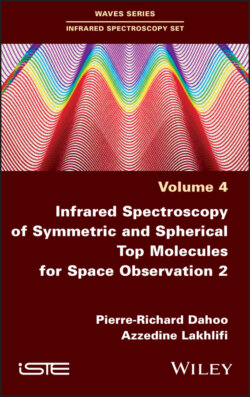Читать книгу Infrared Spectroscopy of Symmetric and Spherical Top Molecules for Space Observation, Volume 2 - Pierre-Richard Dahoo - Страница 9
Оглавление
Foreword
Spectroscopy is the high road to physico-chemical measurements of astrophysical objects, such as the interstellar medium, stars or planets and exoplanets. In recent decades, the understanding of the increasingly finer details of the interaction between matter and radiation, as reflected in the spectral range by effects, sometimes unexpected, on the observed spectra, has led to outstanding advances in spectroscopy, from ground- or space-based observations. For this purpose, increasingly sophisticated instruments were developed for space probes, initially inspired by laboratory instruments, in order to cope with the severe constraints of space observation and exploration.
The challenge of laboratory spectroscopy presented in this book, the fourth volume in this series, resides not only in registering increasingly complex spectra, even for the simplest molecules observed at high temperature or excited to high vibrational states, but also in understanding specific molecular mechanisms, such as the spectroscopy of molecules in rare gas matrices, clathrates or physico-chemical mechanisms related to the adsorption on graphite substrates. These mechanisms can be used to extrapolate to the very specific conditions of the interstellar medium, where the very rich chemistry discovered by the observations in the millimetric range in the last 50 years is highly dependent on ion–molecule–substrate mechanisms.
Spatial instrumentation in remote spectroscopy offers the possibility of exploring planets with atmospheres, particularly by means of instruments with medium to high resolution. However, Earth observations should be treated separately, as they have other objectives, particularly operational ones, and a different approach and constraints compared to the various distant exploration missions, even though they involve similar categories of instruments. Fourier transform spectrometers have measured, in particular, the atmospheres of Mars, Venus and giant planets and their satellites, thanks to their performances in combining large spectral extent and (relatively) high resolution. The pioneering missions were Mariner, Venera and Voyager. Grating or prism spectrometers, particularly those using adjustable prisms (AOTF – Acoustic Optic Tunable Filter), have also provided remarkable results on Mars and Venus. After the first observations using variable circular filter spectrophotometry (IKS on Vega probe), comets, with their highly specific atmosphere, were observed with grating spectrometers (VIRTIS on Rosetta), which led to a better understanding of their composition and revealed surprising isotopic ratios.
Substrate spectroscopy issues are connected with planetary studies in order to understand the adsorption chemistry at play in the interstellar medium, as well as in the very high atmosphere of planets: one of the key results of the Cassini mission showed that the complex hydrocarbons observed on Titan were generated not only from the photochemistry of nitrogen or methane atmosphere at the level of high clouds, but also in the ionic chemistry of the very high atmosphere, measured directly using mass spectrometry from the instrument aboard the Cassini during its flight over Titan.
There is no doubt that there is still room for embedded spectroscopy to significantly evolve into future space missions: Raman spectroscopy methods, still fresh on planetary probes (Mars Curiosity and Perseverance missions), LIDAR observations or the CRDS technique will lead the way to new advances, which laboratory techniques and theoretical models will help to interpret. The joint progress of various disciplines of chemistry, spectroscopy and of Earth and universe sciences is a remarkable example of a coordinated multidisciplinary approach that involves the joint research efforts of laboratories of various specializations. This book, the fourth volume in the series “Infrared Spectroscopy of Molecules for Space Observation”, focuses on the context and results of this research.
Pierre DROSSART
Paris Institute of Astrophysics, CNRS, Sorbonne University
June 2021
